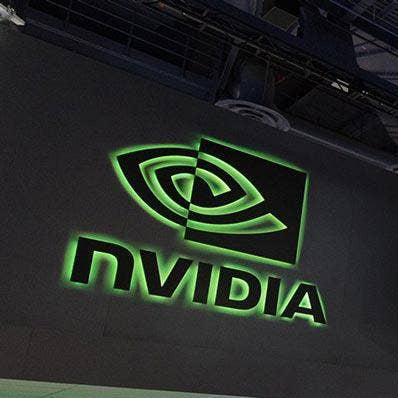Nvidia Says Mellanox Slowdown Expected To End Data Center Rally
‘I fully expect future cloud data centers, all future data centers are going to be connected with high-speed networking inside,’ Nvidia CEO Jensen Huang says as the chipmaker projects that a slowdown in sales for Mellanox products will cause data center revenue to decline sequentially for the first time in more than a year and a half.

Nvidia CEO Jensen Huang said his company’s Mellanox networking business is in the “early inning of growth” after the chipmaker projected that a slowdown in sales in the fourth quarter will cause data center revenue to contract sequentially for the first time in more than a year and a half.
While the company reported strong overall results for its third quarter Wednesday, Nvidia CFO Collette Kress said in the company’s earnings call that data center revenue in the fourth quarter is expected to contract “slightly” due to a “meaningful sequential revenue decline” for Mellanox products.
[Related: 5 Big Things To Know About The $40B Nvidia-Arm Acquisition]
This decline will break a six-quarter sequential growth spurt for the company’s data center business, which has largely been driven by the growing prevalence of its GPUs but then received a major boost earlier this year after Nvidia acquired Mellanox Technologies for $7 billion.
After the Mellanox acquisition closed in April, the company began incorporating revenue from Mellanox’s networking products, which include InfiniBand interconnects and network interface cards, into the data center segment, starting with the second quarter. That quarter, Mellanox accounted for just a little over 30 percent of data center revenue, which prompted the segment to eclipse Nvidia’s sales for gaming GPUs for the first time, driving year-over-year growth to 167 percent.
In the third quarter, Mellanox products accounted for roughly a third of data center revenue, an even larger portion of the segment. At $1.9 billion, it marked another record for quarterly revenue in the data center and year-over-year growth was just a few points short of the previous quarter, at 162 percent.
Kress said Mellanox sales grew double digits from the second quarter, and it reflected a large volume of sales to a server OEM in China. However, those sales to the OEM aren’t expected to repeat in the fourth quarter, which is why the company expects Mellanox sales to decline sequentially in the fourth quarter. Mellanox sales are still projected grow year-over-year, at 30 percent.
The company’s data center GPU products, on the other hand, are expected to grow in the mid-single digits in the fourth quarter sequentially, according to Kress.
Huang said he’s very bullish on the future of Mellanox’s products in the data center, which he expects will be driven by a move from a traditional hyperconverged infrastructure for servers to “microservices-based, software-defined disaggregated architectures.”
“I fully expect future cloud data centers, all future data centers are going to be connected with high-speed networking inside — they call it east-west traffic — and all of the traffic will be secure,” he said. “And so imagine building firewalls into every single server. And imagine every single transaction, every single transmission inside the data center to be high speed and fully encrypted.”
Connected to this vision are the company’s BlueField data processing units, or DPUs, that combine Mellanox SmartNIC technology with Arm processor cores and, in some cases, Nvidia GPUs, with the goal of offloading critical server workloads from the CPU to improve data center economics and introduce new security capabilities. The company revealed a new family of BlueField DPUs at Nvidia’s GTC 2020 virtual conference in October.
“The importance is really quite tremendous,” Huang said. “And I believe, therefore, that every single server in the world will have a DPU inside someday, just because we care so much about security and just because we care so much about throughput and [total cost of ownership].”
Asked by an analyst if Huang thinks Nvidia’s data center GPU revenue growth is being constrained by any factors, the CEO said the company’s grown in the near term is “more affected by the cycle of manufacturing and flexibility of supply.”
“We‘re in good shape, and all of our supply informs our guidance,” he added. “But we would appreciate shorter cycle times. We would appreciate agile supply chains. But the world is constrained at the moment, and so we just have to make the best of it.”
Eliot Eshelman, vice president of strategic accounts and high-performance computing initiatives at Plymouth, Mass.-based Nvidia partner Microway, said his company has seen strong adoption of Nvidia’s GPUs this year, between DGX systems and systems Microway builds and sells to HPC customers.
“With every generation, a higher and higher percentage of our customers are putting GPUs into their clusters,” he said. “There are still laggards that are CPU only, but it‘s pretty rare to see a cluster go out the door without some kind of GPU in it.”
One reason for increased adoption is the barrier to entry is getting lower for HPC users, largely thanks to a variety of software applications supporting GPU acceleration, Eshelman said. Once GPU acceleration is supported, it becomes an easier sell from an economics perspective.
“If your code is GPU-accelerated, you‘re going to get a good cost-effective acceleration,” he said.
Nvidia’s revenue for the third quarter of its 2021 fiscal year was $4.7 billion, a 57 percent increase over the same period last year and $310 million higher than what Wall Street analysts expected. The company’s net earnings were $2.91 per share, 36 cents above analyst expectations.
While data center is expected to decrease sequentially in the fourth quarter, gaming revenue is expected to continue growing in what is typically a down quarter for the company. Those factors will contribute to a projected $4.8 billion in total revenue, plus or minus 2 percent, for the fourth quarter, which would amount to a roughly 54 percent year-over-year increase.
The company’s stock price was down nearly 2 percent in after-hours trading.